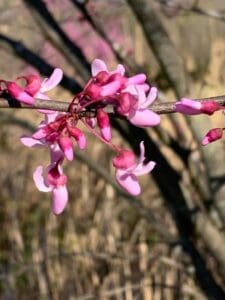By Bill Kinsland, WRWH Weather Reporter

Redbud Tree Highway 17 at the entrance to Hardman Farm- Photo Bill Kinsland
(Sautee)- The late-winter landscape across the mountains is relatively colorless until the early days of March when… gradually… a purple-pink streak appears here and there on twigs and branches. The Redbud is a native tree to the forests of the eastern United States, preferring moist valleys and slopes. Here in the mountains, it is rarely seen at elevations above 1800 feet. Many examples are found throughout Smithgall Woods and Nacoochee Valley and in other nearby forests. It is one of the very first trees to bloom each year, long before its leaves appear.
–
– Each flower is only about ½ inch to ¾ inch in length, somewhat reminiscent of a pea, with 5 irregular purple-pink petals. The flowers occur in clusters of 4 to 8 flowers on a leafless stalk. The flowers are edible as a component of salad.
–
-The tree can grow up to 40 feet at maturity with a trunk diameter as great as 8 to 10 inches. The Redbud’s bark is quite smooth and gray on young trees. As the tree matures, the bark becomes more brown, developing prominent furrows with scale-like plates. Leaves are 2.5 to 5 inches long and nearly as broad, heart-shaped with several prominent veins. They turn yellow in autumn.
–
-The inner bark has astringent medical properties which were used by early American practitioners to treat diarrhea and dysentery. (Caution: Consult your physician before using this plant for medical purposes!)
–
– The tree propagates with seeds carried in a flat, oblong pod that turns black and falls to the ground in autumn and splits open on the edge, releasing the seed. The seed itself is a black, flat oval-shaped bean.
The tree propagates with seeds carried in a flat, oblong pod that turns black and falls to the ground in autumn and splits open on the edge, releasing the seed. The seed itself is a black, flat oval-shaped bean.
 The tree propagates with seeds carried in a flat, oblong pod that turns black and falls to the ground in autumn and splits open on the edge, releasing the seed. The seed itself is a black, flat oval-shaped bean.
The tree propagates with seeds carried in a flat, oblong pod that turns black and falls to the ground in autumn and splits open on the edge, releasing the seed. The seed itself is a black, flat oval-shaped bean.–
-The “Judas Tree” nickname comes from a legend about Judas Iscariot who hanged himself when it still had white flowers which, then, turned pink-purple. Indeed, a very similar species of Redbud (Cercis siliquastrum) does grow in Palestine.




